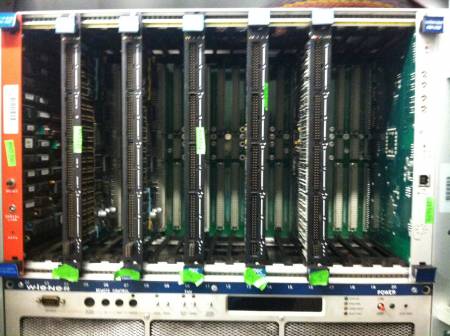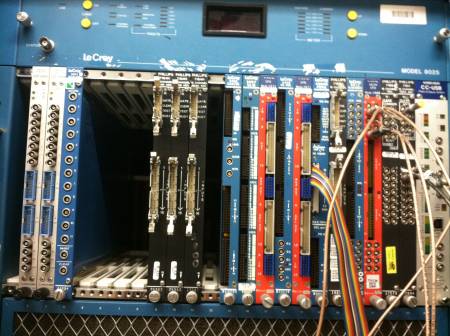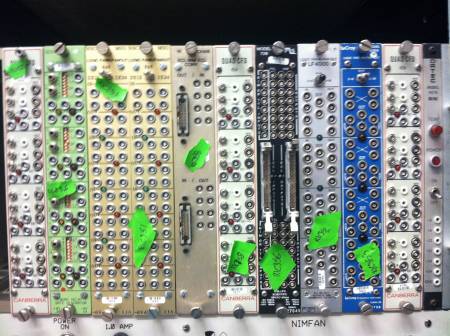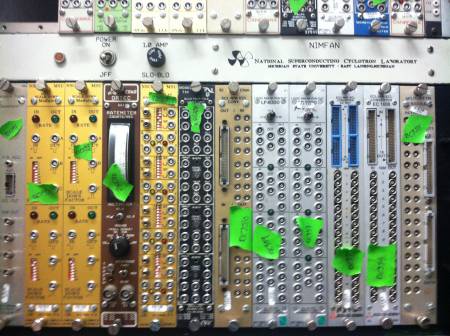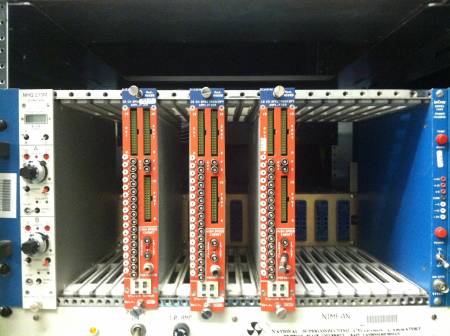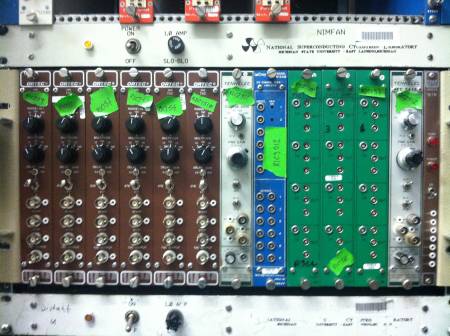This is an old revision of the document!
Table of Contents
Electronics
Crate Configuration
Most of the S800 electronics is installed in two racks inside the cabinet seating on the top level of the S3 vault, right in the north side of the focal plane station chamber (see picture below). There is a total of six crates mounted in the two racks. The left rack contains a CAMAC crate on the top and two NIM crates, NIM crate 1 on the middle and NIM crate 2 on the bottom. The right rack includes a VME crate on the top, NIM crate 3 on the middle and NIM crate 4 on the bottom.
VME crate
CAMAC crate
NIM crate 1
NIM crate 2
NIM crate 3
NIM crate 4
Inventory Modules
In progress.
Electronic Diagrams
Documentation
- Manuals for electronic modules
- Firmware FPGA Schematics
Timing
In a typical S800 experiment, there are different time-of-flight (ToF) measurements that can be used to identify the fragments of interest. The most common timing-signal sources used are the RF cyclotron; the thin plastic scintillator at the A1900 focal plane box (XFP); the thin plastic scintillator at the S800 Object station (OBJ), and the S800 FP scintillator (E1) with two signals, one from the “up” and one from the “down” photomultipliers.
Although it is possible to measure the ToF between any pair of timing sources, there are three “standard” measurements provided to any experiment, namely, between the cyclotron and the S800 FP (RF-FP); between the A1900 FP and the S800 FP (XFP-FP); and between the S800 OBJ and FP (OBJ-FP). These ToFs are electronically recorded in a Phillips 7186 TDC, a Mesytec TDC (MTDC), and a group of Ortec 566 TACs, all them located in the electronic racks in S3, near the FP box.
Although the timing reference (“start”) in the all the ToF modules is given by the FP scintillator E1 up, the electronic path from the detector to each module is different (see main electronics diagram for more details).
Some important things to know about each of these modules:
MTDC
- This module has multi-hit capabilities and better time resolution than the Phillips TDC and TACs. However, it is not yet in production mode
- Before getting into the MTDC, the OBJ, XFP, and E1 up signals go through a Mesytec CFD (MCFD) in the S3 electronic racks
- The OBJ signal into the MCFD comes directly from the detector via S3 patch panel #94
- The XFP detector signal is sent to a CANBERRA CFD 454 CFD in data U6 (patch panel #1 from data U1). The output from the CFD is then sent back to the MCFD in S3 via patch panel #70
- The MTDC timing signals do not require external delay adjustments because the matching window is sufficiently wide
- SpecTcl calculates the OBJ-FP and XFP-FP ToFs by substracting the E1 up time (MTDC channel 15) to the OBJ time (MTDC channel 3) and the XFP time (MTDC channel 2)
Tennelec TACs
- Unlike the MTDC and Phillips TDC, there is no TAC for the RF-FP ToF
- Before going to their corresponding TAC, the OBJ and XFP detector signals are sent to a CANBERRA CFD 454 CFD in data U6 via patch panel #54 and #1, respectively
- The OBJ output from the CANBERRA 454 CFD is sent to the stop of OBJ-FP TAC via patch panel #62
- The XFP output from the CANBERRA 454 CFD is sent to the stop of XFP-FP TAC via patch panel #70
Phillips TDC
- Before going to the TDC, the OBJ and XFP detector signals are sent to a CANBERRA CFD 454 CFD in data U6 via patch panel #54 and #1, respectively
- The TDC start is provided by the ULM trigger module. Since the delay of the S800 trigger may be adjusted during tuning of the S800 (XDT), the stop signals (e.g. from OBJ or XFP) need to be re-adjusted so that the ToF fits into the 400-ns range of the TDC. This is done manually for OBJ and XFP, and remotely (via delay GUI) for other timing signals
- The OBJ output signal from the CANBERRA 454 CFD is delayed with the low-noise delay boxes in data U6, and sent to the TDC via patch panel #67
- The XFP output signal from the CANBERRA 454 CFD is delayed with the low-noise delay boxes in data U6, and sent to the TDC via patch panel #66
- SpecTcl calculates the OBJ-FP and XFP-FP ToFs by substracting the E1 up time (channel 8) to the OBJ time (channel 14) and the XFP time (channel 15)


